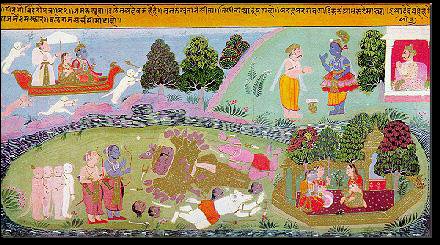Tweet

"Janakasuta... deva he hare raja ne namskara: baleraja sarvatha mota ho."
Krsna is invoked in this verse as Rama in accordance with the dasavatara prabandha. Janaka's daughter Sita adorns him, he is the conqueror of the demon Dusana, the killer of the tenheaded Ravana.
Each epithet is recreated pictorially. On the extreme top, sit Rama and Sita in a boat escorted by Hanuman and a fleet of monkeys. The dynamic movement of the monkeys is contrasted with the dignified quality of Rama and Sita. Below, in a large spatial area, we witness the battle of Lanka. The vanquished demons Khara and Dusana are seen fleeing in fright. Ravana lies slain with decapitated heads scattered in all directions. Here the artist restricts himself to the battle scene with Rama, Laksmana and the monkeys on one side, and the demons on the other. Sita in the asoka vatika provides the background for the battle scene. She sits with two attendants behind a wall. The total battle scene comprising the scene of Sita, and that of the battle of Rama and Ravana, is framed by lines suggestive of the waters. Trees appear only in the context of the asoka vatika scene and are in the distant background. The latter are used as space dividers to distinguish the scene of Rama, Laksmana, Sita, Krsna, and the single devotee.
The technique of communicating the refrain group is modified. Now there is only a single devotee standing with folded hands before Krsna. In a niche, as if overlooking the whole drama, sits the patron king. The painting is interesting for the effective use of spatial areas, the delineation of the trees, boats, and battle scenes at the descriptive level.

